GAO Says Lessons of Broadband Stimulus Won’t Be Learned Before Round 2
WASHINGTON, November 19, 2009 – The Government Accountability Office on Monday released a report analyzing the possible challenges faced by the National Telecommunications and Information Administration and the Rural Utility Service when they implement the broadband stimulus. The largest problem th
WASHINGTON, November 19, 2009 – The Government Accountability Office on Monday released a report analyzing the possible challenges faced by the National Telecommunications and Information Administration and the Rural Utility Service when they implement the broadband stimulus.
The largest problem that the GAO saw was that after 2010, both agencies will no longer have any funding to provide oversight to projects. Additionally, they currently lack enough staff to properly provide oversight. In the 2010 budget request to Congress, NTIA asked for an additional 40 full-time employees; RUS asked for 47.
The other major challenge faced by the agencies, according to GAO, is determining who should receive funds. While the Notice of Funds Availability delineated specific guidelines for which projects were eligible to be funded, no group currently has a map showing where broadband is currently available.
While the NTIA has began to award funds to the states to begin their mapping efforts, the majority of these maps will not be available for another two years. Currently, the only data available comes from the Federal Communications Commission’s Form 477 database. Such data, whose disclosure to the public has been circumscribed, was not intended to be used for such a broadband stimulus process.
This lack of existing service also poses a problem in verifying challenges to applications by the existing providers, said GAO.
The shortened period between the first and second round of funding does not allow for the NTIA or RUS to modify procedures if they do not work, said GAO. This short period also does not allow applicants to send in comments that could be evaluated and acted upon by NTIA or RUS.
In order to solve these problems, the GAO recommended the following three actions be taken:
- Delay the issuance of the second NOFA to analyze the process and apply lessons from the first round.
- Determine a way to obtain additional funding past 2010 to continue to provide oversight to projects.
- Develop quantifiable outcome based performance goals to measure the program.
The NTIA and RUS attached letters of response to the GAO report. The letter from the NTIA stated that it was looking into the issues to try to resolve them. The response from RUS went into greater detail on how the agency had already begun to examine the issues and was seeking to solve them. The agency did feel, however, that the staffing issues had been blown out of proportion; they said they had enough staff to handle the program.








Member discussion